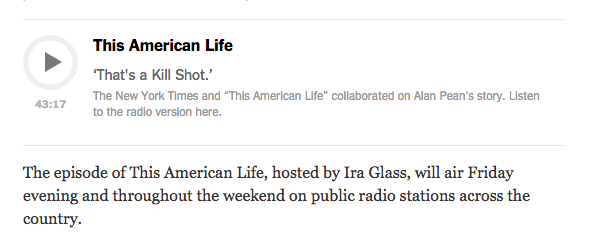
Last August, a college student named Alan Pean was Tasered and shot in the chest by two security guards shortly after seeking treatment for a psychotic episode at a Houston hospital. Pean is the subject of a major New York Times story by Elisabeth Rosenthal that was published Friday morning, which serves as a look at the ramifications of hospital security personnel increasingly being allowed to carry deadly weapons the job.
The Times isn’t just telling Pean’s story through the classic mix of print and images. The paper has also teamed up with This American Life, the legendary public radio team led by Ira Glass, to (quite literally) give voice to Pean’s story.
This American Life’s complementary report will be broadcast on public radio stations over the weekend, and will also be made available as a podcast for download on Sunday evening at 7 p.m. ET. It’s available for streaming now on the Times’ website.

The teams reported the story out in tandem, sharing both print and audio drafts with each other throughout the process. As This American Life editor (and former New York Times Magazine editor) Joel Lovell told me in an email, the Times’ decision to collaborate with the show was driven by a desire to draw out great emotional resonance:
“Libby Rosenthal was reporting the story and she and some colleagues at the Times (Rebecca Corbett and Catrin Einhorn) had a sense that there were aspects of the story that would make great audio — Alan Pean’s ability to describe his experience so vividly, the way the Pean family described their emotional experience — and that those things would necessarily get short-shrifted in a print story, with its inherent space limitation and focus on the larger issue of armed security in hospitals.”
“We thought having these complementary stories together would be an appealing package for readers and listeners,” said Corbett, who edited the article. “They can be a bit more discursive than we can. The show has this conversational quality, so Ira was able to explore a few more themes and explore them a bit more deeply than our story. We had to be more selective.”
For the New York Times, the report is yet another fascinating experiment with the audio format. Last month, the paper enjoyed the successful launch of the Modern Love podcast, an adaptation of the popular column, which they produced in partnership with Boston public radio station WBUR. The paper plans to create more shows in the coming months.This isn’t This American Life’s first investigative collaboration with another publication. Over the past few years, the radio show has co-produced several hard-hitting stories with ProPublica, most memorably with the 2014 report “The Secret Recordings of Carmen Segarra,” which provided an unprecedented look into the New York Federal Reserve — and its regulatory capture — by a former Fed Bank examiner.
It’s a great time for This American Life. Last summer, the show broke away from Chicago Public Media — its home for 20 years — and was restructured as a public benefit corporation, giving creator Glass full control over the show’s creative and economic fate. Its spin-off Serial, the wildly popular podcast that launched a thousand podcasts, is currently in its second season. The team is also working on “some new shows,” according to Lovell, along with another collaboration with ProPublica and The Marshall Project.When asked about the current frothy “moment” that radio and podcasting is having, Glass quipped: “We think it’s great. And we’re going to ride this bubble until it bursts.”
Nicholas Quah runs Hot Pod, a weekly newsletter on the state of the podcast world; it appears on Nieman Lab on Tuesdays.